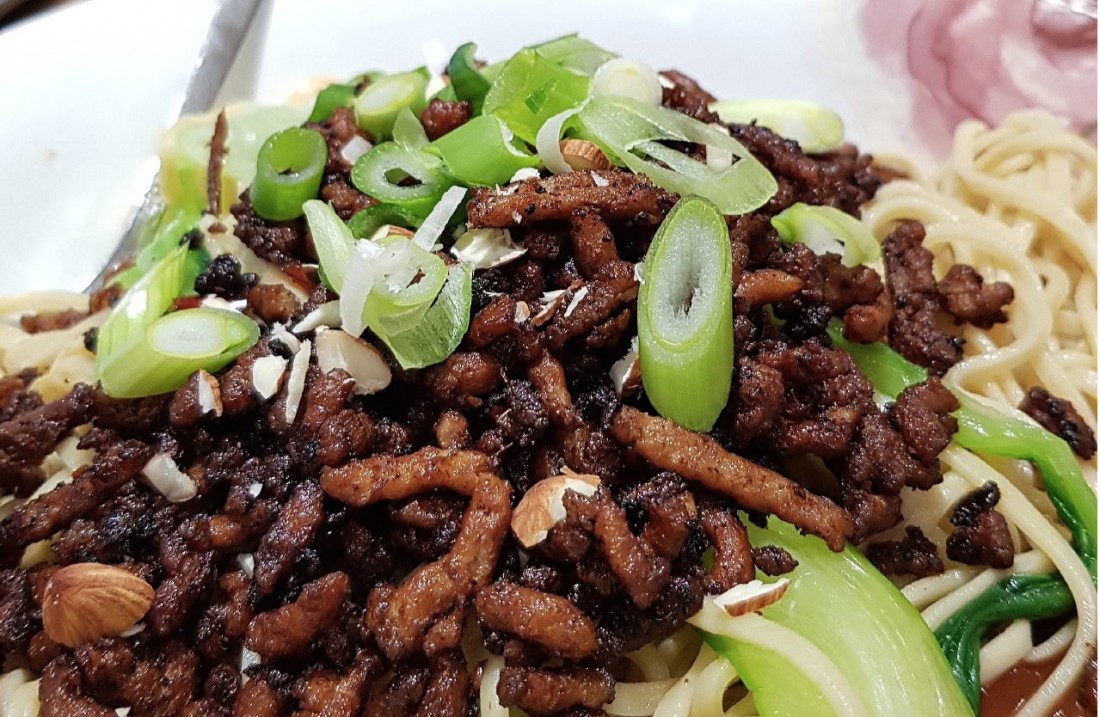It’s amazing what you can do when you’re forced into a culinary corner. Last week, I found myself in such a corner and in retrospect, it wasn’t a bad place to be.
I had been introduced, you see, to dandan noodles the week previous by a friend at work and without putting too fine a point on things, I LOVED them.
Spicy, rich, meaty, unctuous… they were antithesis to my usual starting point (preconception) on Chinese food which is, everything’s too garish to be great.
Ronan’s noodles though, they were a revelation! Upon devouring my first ever bowl I cleaned said receptacle with my thumb and swore to whatever deities were listening, that I would have a crack at the recipe in the coming days. That ‘day’ was Saturday night past and before I knew where I was, the culinary corner beckoned.
I had heard of dandan noodles of course, much in the same way I’ve heard of pad Thai noodles or katsu chicken. But in terms of first hand cooking experience, I was sadly lacking. I was therefore much chagrined to realise that some of the key ingredients for dandan noodles are not lining our local supermarket shelves. I could not, for example, find Sichuan pepper or sui mi ya cai (Chinese pickled vegetables) or Chinese chilli paste or even tahinni paste but since I’d painted myself into that aforementioned corner by buying everything else I needed, I decided some invention was the order of the day.
To gather some extra dandan know-how, I hunted out a few other recipes for the same dish (which I have also discovered are as diverse as the countries they hail from) and set about making my own bastardised version. I had not the foggiest idea if my plan would work but, I hasten to add, I was over-eager to try. My thinking was: If I could replicate even a fraction of the satisfaction which Ronan’s dandan provided, I wouldn’t go too far wrong.
The end result was not perfect, I will freely admit. Herself awarded the final bowl a decent 8.5/10 which I was more than satisfied with and to give you an idea of how much I liked them, I ate them three times over the course of two days. Suffice it to say, at the time of writing, I am fairly dandan-ed out but I can’t help but smile at the fact that my invention worked – kind of.
It turns out, as I suspected it might, that even second rate dandan noodles are excellent and at the very least, much better than no dandan noodles at all.
Apart from chicken fried rice and its many variables, I am not the most proficient exponent of Chinese cuisine. However, I now understand only too well that my own version of dandan noodles is but a hair’s breadth away from perfection – given more of the right ingredients.
Just in case you were wondering, the name ‘dandan’ refers to a type of pole that was used by the street vendors who sold the dish to passers-by. The pole was hoisted over the shoulder, with two baskets containing noodles and sauce attached at either end. As the noodles were affordable due to their low cost, the local people gradually came to call them dandan noodles. The name translates directly as “noodles carried on a pole.”
I should also point out at this juncture that whilst this recipe for dandan noodles may look a little daunting, everything will come together well in the end. Don’t give up! Fortune favours the desperate!
INGREDIENTS (feeds four)
• 1 tbsp of sesame oil
• 1 garlic clove, finely sliced
• 1 red chilli, finely chopped
• 2cm piece of ginger, peeled and finely chopped
• half tsp of white peppercorns (in the absence of Sichuan), lightly crushed in a mortar and pestle
• 500g of pork mince
• 250g of noodles, I used medium egg noodles
• 2 pak choi, washed, trimmed and roughly chopped
• 2 tbsp of unsweetened peanut butter (which I used in place of the tahinni).
• 2 tbsps of Sichuan sauce (in the absence of chilli bean paste). I used a Blue Dragon sachet.
• quarter tsp of five spice
• 3 tbsp of light soy sauce
• 2 tbsp of Chinese rice wine vinegar
• sliced spring onions and roasted peanuts (crushed) to serve.
THE PLAN
Heat the sesame oil in a wok or in my case, a large frying pan. Once really hot, add the garlic, chilli, white pepper corns and ginger and sizzle for 20 seconds.
Dump in the mince and continue to cook over a high heat, breaking it up as you go, for about ten minutes, until any water is gone and the pork is crisping up nicely. Add one tbsp of the soy and one of the rice vinegar, stir it through and that’s done. Turn the heat down to virtually nothing, just to keep it warm.
Cook the noodles as per packet instructions adding the pak choi for the last two minutes. When cooked, drain the noodles, retaining 200ml of the cooking liquor.
To make the sauce, add the peanut butter, Sichuan sauce, two tbsps of the soy sauce, the five spice and one tbsp of the rice wine vinegar to a small pan. Add heat to the equation and then add the noodle cooking liquor.
Let it bubble a little until it thickens slightly. Divide the sauce between four bowls, place the noodles and pak choi on top, divide up the pork between the four then scatter spring onions and crushed peanuts. It may not be the prettiest of pictures or even the best dandan noodles I’ve ever had, but they still taste amazing.
No doubt, I’ll dandan myself out this weekend too.







